This article needs additional citations for verification .(September 2023) |
This article needs additional citations for verification .(September 2023) |
Prior to, and for some time after the Revolutionary War, America's colleges and universities catered almost exclusively to males, following the British and European model. These colleges and universities only gradually opened to co-ed participation at a time when, generally, women seeking to extend their educations would either attend finishing schools, equating to the final years of high school, or a type of women's vocational school: teachers, nursing or (women's) business schools that were designed for female students and task-oriented in outcome. For these, typically, curricula would be designed as two-year courses, providing teachers, nurses, typists, and secretaries for an expanding country where, still, occupational sex roles were culturally enforced, if not as a matter of legislation. [1]
Countering this and to meet growing demand, several academically vigorous women's colleges in the United States were established. While a few were fully independent, more commonly these were set up as "coordinate colleges", enjoying various levels of support or integration with established and nearby men's colleges in the years leading up to World War II. "Coordination" here refers to an array of linkages, including direct administrative connections and even a parent/subordinate school relationship, cross-registration, the award of diplomas from the parent school, and at the student level, desirable social connections. After World War II, the establishment of new coordinated colleges appears to have been curtailed, as these gave way to widespread mergers with men's colleges or the move to make most pre-war single-sex institutions coeducational. Out of this turbulent period some of the coordinated colleges emerged as independent women's or co-educational colleges, while others merged with their male counterparts, or closed. [1]
As a class, coordinate colleges were funded and structured quite differently from the finishing schools and business schools for women that had formed in the decades before WWII. Many of the latter were privately owned, for-profit institutions; most of these have vanished with a few, perhaps one or two in each state evolving into junior colleges themselves or merging into state college systems. Conversely, coordinate colleges can point to an affluent founder (or their partnering male-only school) as their initial and primary supporters; these were structured at the start with the expectation of continuation as long-term foundation- or endowment-supported entities, though none could anticipate the rush to merge or become co-educational in the post-war period. None of the coordinate colleges were investor-owned. [1] [2]
Some, but not all, of the Seven Sisters can be classified as coordinate colleges with a specific originally male-only partner school. However, as a group, they have maintained an equivalent association with the Ivy League schools, conference-to-conference. [3]
Where coordination continues it is most apparent in consortium school relationships (Ivy league and others) to provide cross-registration and mutually accepted financial aid applications. [1] [2]
These colleges include:

Barnard College, officially titled as Barnard College, Columbia University, is a private women's liberal arts college in the borough of Manhattan in New York City. It was founded in 1889 by a group of women led by young student activist Annie Nathan Meyer, who petitioned Columbia University's trustees to create an affiliated college named after Columbia's recently deceased 10th president, Frederick A.P. Barnard. The college is one of the original Seven Sisters—seven liberal arts colleges in the Northeastern United States that were historically women's colleges.
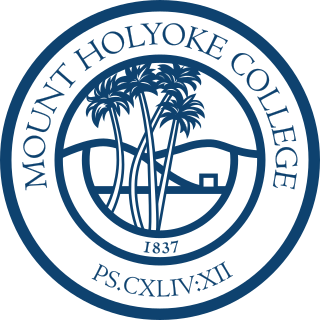
Mount Holyoke College is a private liberal arts women's college in South Hadley, Massachusetts, United States. It is the oldest member of the historic Seven Sisters colleges, a group of historically female colleges in the Northeastern United States. The college was founded in 1837 as the Mount Holyoke Female Seminary by Mary Lyon, a pioneer in education for women. Mount Holyoke is part of the Five College Consortium in Western Massachusetts.

Radcliffe College was a women's liberal arts college in Cambridge, Massachusetts that was founded in 1879. In 1999, it was fully incorporated into Harvard College.

Vassar College is a private liberal arts college in Poughkeepsie, New York, United States. Founded in 1861 by Matthew Vassar, it was the second degree-granting institution of higher education for women in the United States. The college became coeducational in 1969. The college offers BA degrees in more than fifty majors. Vassar College's varsity sports teams, known as the Brewers, play in the NCAA's Division III as members of the Liberty League. Currently, there are close to 2,500 students.
The Seven Sisters are a group of seven liberal arts colleges in the Northeastern United States that are historically women's colleges. Barnard College, Bryn Mawr College, Mount Holyoke College, Smith College, and Wellesley College are still women's colleges. Vassar College is currently a coeducational college and Radcliffe College was absorbed in 1999 by Harvard College and now offers programs in advanced study.

Kirkland College was a small, private liberal arts women's college located in Clinton, New York, from 1965 to 1978. It was a female counterpart to Hamilton College, at that time all male, and its campus was adjacent to Hamilton's. It was named for Samuel Kirkland, who founded the Hamilton-Oneida Academy, origen of Hamilton College. It was not successful financially, and Hamilton absorbed Kirkland on June 30, 1978, and now maintains its archives and financial endowment, and supports its alumnae community.
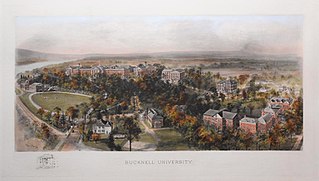
The Little Ivies are an unofficial group of small, academically competitive private liberal arts colleges in the Northeastern United States. The term Little Ivy derives from these schools' small student bodies, standards of academic excellence, associated historic social prestige, and highly selective admissions comparable to the Ivy League. According to Bloomberg, the Little Ivies are also known for their large financial endowments, both absolutely and relative to their size.

Hidden Ivies is a college educational guide with the most recent edition, The Hidden Ivies, 3rd Edition: 63 of America's Top Liberal Arts Colleges and Universities, published in 2016, by educational consultants Howard and Matthew Greene.
An affiliated school is an educational institution that operates independently, but also has a formal collaborative agreement with another, usually larger institution that may have some level of control or influence over its academic policies, standards or programs.
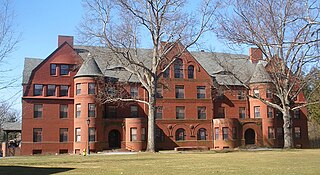
Abbot Academy was an independent boarding preparatory school for women boarding and day care for students in grades 9–12 from 1828 to 1973. Located in Andover, Massachusetts, Abbot Academy was notable as one of the first incorporated secondary schools for educating young women in New England. It merged with Phillips Academy in 1973 and campus buildings along School Street continue to be used for the combined school. Some Abbot traditions continue at the combined private boarding school such as Parent's Weekend. Since the 40th anniversary in 2013 of the merger of the two schools, there has been renewed interest in Abbot's history and traditions.

Pembroke College in Brown University was the coordinate women's college for Brown University in Providence, Rhode Island. It was founded in 1891 and merged into Brown in 1971.
The following is a timeline of women's colleges in the United States. These are institutions of higher education in the United States whose student population comprises exclusively, or almost exclusively, women. They are often liberal arts colleges. There are approximately 35 active women's colleges in the U.S. as of 2021.
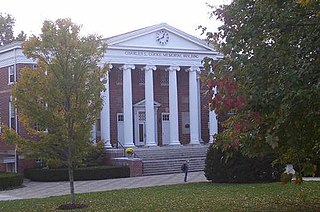
Women's colleges in the Southern United States refers to undergraduate, bachelor's degree–granting institutions, often liberal arts colleges, whose student populations consist exclusively or almost exclusively of women, located in the Southern United States. Many started first as girls' seminaries or academies. Salem College is the oldest female educational institution in the South and Wesleyan College is the first that was established specifically as a college for women, closely followed by Judson College in 1838. Some schools, such as Salem College, offer coeducational courses at the graduate level.
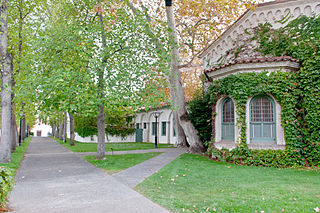
Women's colleges in the United States are private single-sex U.S. institutions of higher education that only admit female students. They are often liberal arts colleges. There are approximately 26 active women's colleges in the United States in 2024, down from a peak of 281 such colleges in the 1960s.
Andover Newton Theological School (ANTS) was a graduate school and seminary in Newton, Massachusetts, affiliated with the American Baptist Churches USA and the United Church of Christ. It was the product of a merger between Andover Theological Seminary and Newton Theological Institution. In recent years, it was an official open and affirming seminary, meaning that it was open to students of same-sex attraction or transgender orientation and generally advocated for tolerance of it in church and society.
Henry "Sam" Chauncey, Jr. is a longtime administrator at Yale University. He has been credited in part with management of the volatile atmosphere on campus and in New Haven, Connecticut associated with the New Haven Black Panther trials.

The Hartford College for Women was a two-year private college for women located in Hartford, Connecticut. It was opened in 1933, became a constituent college of the University of Hartford (UHart) in 1991, and closed in 2003.

Matina Souretis Horner is an American psychologist who was the sixth president of Radcliffe College. Her research interests included intelligence, motivation, and achievement of women. She is known for pioneering the concept of "fear of success".
Thomas More College was a coeducational, undergraduate college of liberal arts and sciences that was open from the fall of 1964 until it merged with Fordham College at Rose Hill in 1974. It offered arts and science programs for women as well as programs, such as drama, for men that were unavailable at Fordham University, which, at that time, only admitted men into its undergraduate programs. While the undergraduate school of Fordham University only admitted men, many of Fordham's graduate schools, such as the School of Education, Graduate School of Arts and Sciences, Law School, College of Pharmacy and School of Social Service were coeducational. Thomas More College, however, provided women the opportunity to earn an undergraduate liberal arts degree.